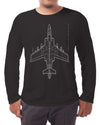
Blackburn Buccaneer S.1 - Long-sleeve T-shirt
£30.00
Blackburn Buccaneer
The Buccaneer first came into service with the Royal Navy as a carrier borne aircraft in 1962. As well as in an anti-shipping role, the Buccaneer was capable of delivering nuclear weapons. When the RN retired the Buccaneer in 1978, the RAF took it on as a low level strike aircraft. It became the S.2B with updated RAF avionics, carried Martel missiles and had an extra fuel tank in its bomb-bay. The low-level performance comes from its robust and durable airframe and the low speed capability is due to boundary layer technology that bled high pressure air from the engine to give the wings more lift. 208 was the last RAF Squadron to operate the 'Bucc', which was disbanded in 1994.
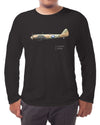
Blenheim - Long-sleeve T-shirt
£27.00
Bristol Blenheim MKIF
From graphic designer and illustrator, Chris Sandham-Bailey of Inkworm.com. Chris is a regular contributor to aviation publications such as Aeroplane and Mortons Media. This profile is Blenheim from 25 Squadron at RAF Debden.
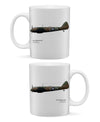
Blenheim - Mug
£11.00
Bristol Blenheim MKIF
This profile is a Blenheim from 25 Squadron at RAF Debden.
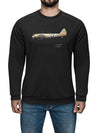
Blenheim - Sweat Shirt
£39.00
Bristol Blenheim MKIF
From graphic designer and illustrator, Chris Sandham-Bailey of Inkworm.com. Chris is a regular contributor to aviation publications such as Aeroplane and Mortons Media. This profile is Blenheim from 25 Squadron at RAF Debden.
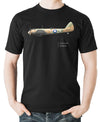
Blenheim - T-shirt
£24.00
Bristol Blenheim MKIF
From graphic designer and illustrator, Chris Sandham-Bailey of Inkworm.com. Chris is a regular contributor to aviation publications such as Aeroplane and Mortons Media. This profile is Blenheim from 25 Squadron at RAF Debden.

Blériot - Hoodie
£45.00
Louis Blériot, the first man to fly across the English Channel
Louis Blériot was a French-born inventor and engineer who had invented and manufactured headlamps for motor cars. Profits from his business were invested in building aeroplanes and Blériot was the first to develop the stick and rudder system of controlling an aircraft. In 1909 he entered his monoplane into the Daily Mail Prize of flying across the English Channel. At sunrise of July 25th he took off from Les Baraques and made it to Dover in just over 23 minutes, making aviation history. This design has been given a deliberate aged and 'weathered' appearance.
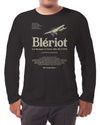
Blériot - Long-sleeve T-shirt
£27.00
Louis Blériot, the first man to fly across the English Channel
Louis Blériot was a French-born inventor and engineer who had invented and manufactured headlamps for motor cars. Profits from his business were invested in building aeroplanes and Blériot was the first to develop the stick and rudder system of controlling an aircraft. In 1909 he entered his monoplane into the Daily Mail Prize of flying across the English Channel. At sunrise of July 25th he took off from Les Baraques and made it to Dover in just over 23 minutes, making aviation history. This design has been given a deliberate aged and 'weathered' appearance.

Blériot - Sweat Shirt
£39.00
Louis Blériot, the first man to fly across the English Channel
Louis Blériot was a French-born inventor and engineer who had invented and manufactured headlamps for motor cars. Profits from his business were invested in building aeroplanes and Blériot was the first to develop the stick and rudder system of controlling an aircraft. In 1909 he entered his monoplane into the Daily Mail Prize of flying across the English Channel. At sunrise of July 25th he took off from Les Baraques and made it to Dover in just over 23 minutes, making aviation history. This design has been given a deliberate aged and 'weathered' appearance.

Blériot - T-shirt
£24.00
Louis Blériot, the first man to fly across the English Channel
Louis Blériot was a French-born inventor and engineer who had invented and manufactured headlamps for motor cars. Profits from his business were invested in building aeroplanes and Blériot was the first to develop the stick and rudder system of controlling an aircraft. In 1909 he entered his monoplane into the Daily Mail Prize of flying across the English Channel. At sunrise of July 25th he took off from Les Baraques and made it to Dover in just over 23 minutes, making aviation history. This design has been given a deliberate aged and 'weathered' appearance.

Bomber Command - Hoodie
£45.00
RAF Bomber Command insignia
RAF Bomber Command was active from 1936 to 1968 with attached squadrons of the RCAF, RAAF and RNZAF. During World War Two aircrews suffered heavy losses with 44% of the force killed in action, 8500 wounded and 840 became POWs. A high price was paid which is now commemorated with a memorial at Lincoln Cathedral and Green Park in London. This design features a battle worn insignia and the motto, 'Strike Hard Strike Sure'.
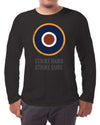
Bomber Command - Long-sleeve T-shirt
£27.00
RAF Bomber Command insignia
RAF Bomber Command was active from 1936 to 1968 with attached squadrons of the RCAF, RAAF and RNZAF. During World War Two aircrews suffered heavy losses with 44% of the force killed in action, 8500 wounded and 840 became POWs. A high price was paid which is now commemorated with a memorial at Lincoln Cathedral and Green Park in London. This design features a battle worn insignia and the motto, 'Strike Hard Strike Sure'.

Bomber Command - Mug
£11.00
RAF Bomber Command insignia
RAF Bomber Command was active from 1936 to 1968 with attached squadrons of the RCAF, RAAF and RNZAF. During World War Two aircrews suffered heavy losses with 44% of the force killed in action, 8500 wounded and 840 became POWs. A high price was paid which is now commemorated with a memorial at Lincoln Cathedral and Green Park in London. This design features a battle worn insignia and the motto, 'Strike Hard Strike Sure'.
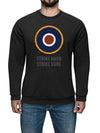
Bomber Command - Sweat Shirt
£39.00
RAF Bomber Command insignia
RAF Bomber Command was active from 1936 to 1968 with attached squadrons of the RCAF, RAAF and RNZAF. During World War Two aircrews suffered heavy losses with 44% of the force killed in action, 8500 wounded and 840 became POWs. A high price was paid which is now commemorated with a memorial at Lincoln Cathedral and Green Park in London. This design features a battle worn insignia and the motto, 'Strike Hard Strike Sure'.
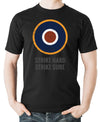
Bomber Command - T-shirt
£24.00
RAF Bomber Command insignia
RAF Bomber Command was active from 1936 to 1968 with attached squadrons of the RCAF, RAAF and RNZAF. During World War Two aircrews suffered heavy losses with 44% of the force killed in action, 8500 wounded and 840 became POWs. A high price was paid which is now commemorated with a memorial at Lincoln Cathedral and Green Park in London. This design features a battle worn insignia and the motto, 'Strike Hard Strike Sure'.

Bristol Aeroplane Company - Hoodie
£48.00
Bristol Aeroplane Company
Founded in 1910 by Sir George White, the Bristol Aeroplane Company is one of Britain's best known manufacturer of airframes and aero engines. At the start of the sixties the company merged with others to form the British Aircraft Corporation. The design has a deliberate 'aged and weathered' look. This design is also available as a t-shirt, long-sleeve t-shirt and sweat shirt.
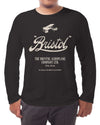
Bristol Aeroplane Company - Long-sleeve T-shirt
£27.00
Bristol Aeroplane Company
Founded in 1910 by Sir George White, the Bristol Aeroplane Company is one of Britain's best known manufacturer of airframes and aero engines. At the start of the sixties the company merged with others to form the British Aircraft Corporation. The design has a deliberate 'aged and weathered' look. This design is also available as a t-shirt, sweat shirt and hoodie.
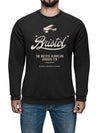
Bristol Aeroplane Company - Sweat Shirt
£39.00
Bristol Aeroplane Company
Founded in 1910 by Sir George White, the Bristol Aeroplane Company is one of Britain's best known manufacturer of airframes and aero engines. At the start of the sixties the company merged with others to form the British Aircraft Corporation. The design has a deliberate 'aged and weathered' look. This design is also available as a t-shirt, long-sleeve t-shirt and hoodie.
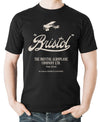
Bristol Aeroplane Company - T-shirt
£24.00
Bristol Aeroplane Company
Founded in 1910 by Sir George White, the Bristol Aeroplane Company is one of Britain's best known manufacturer of airframes and aero engines. At the start of the sixties the company merged with others to form the British Aircraft Corporation. The design has a deliberate 'aged and weathered' look. This design is also available as a long-sleeve shirt, sweat shirt and hoodie.
